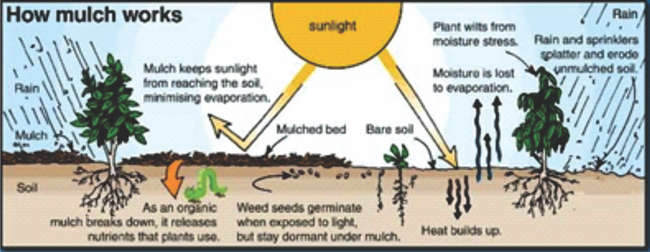Margaret Legg
As we all know rainfall this year has been extremely low. According to UCCE the rainfall total for this calendar year in the Carneros and Oakville region is recorded as 4.51 inches. If one considers the “rainy” season from October 2021 to the present the total would be 20.86 inches, it's still quite below our average annual rainfall of 26-28 inches as referenced by City of Napa Utilities/Water Division. We all have a responsibility to do what we can to conserve this precious commodity and analyze our usage. Give cold tap water that would otherwise go down the drain a second chance and water something outside. Every drop counts.
Compost & Mulch…the secret sauce to reducing your water usage in your garden.
|
Mulch |
Mulch |
Mulch |
Mulch |
No Mulch |
No Mulch |
|
As organic mulch breaks down, nutrients are released into the soil. |
Mulch keeps sunlight out, minimizing evaporation. This helps retain water and keep moisture at the roots. |
Without sun weed seeds are suppressed |
Mulch insulates plant roots, protecting them from temperature fluctuations. |
Without mulch heat builds up in the soil and moisture is lost to evaporation. |
Without mulch, rain, and wind cause soil to erode. |
The benefits of compost and mulching:
- Insulates the soil
- Reduces weed seed germination
- Can save 20-30 gallons of water/1000 sq ft each time you water.
- Reduces waste that ends up in landfill
- Amends and improves soil health
- So many more benefits…win-win!
There are multiple options when it comes to compost methods and mulch choices. See references below regarding composting methods including vermicomposting (worm castings). One of the best options for compost to purchase is our own state of the art Napa Recycling Facility.
Watering
Shrink the lawn
- Lawns offer the greatest potential for water conservation. Consider lawn alternatives; reduce your water schedule; water between 3am-8am; explore water reducing sprinkler heads
- Explore the City of Napa's Cash for Grass program (see reference)
- Control weeds. Weeds complete with desired plants for water and nutrients
- Group plants with similar exposure and water needs. Look for native or drought tolerant plants.
- Water deeply, infrequently, efficiently, and always use a timing device.
Watering systems/application options
- Hose and sprinkler: typical garden hose uses 9-17/gal/min. depending on water pressure. I filled a 5 gal. bucket in 25 seconds at 80 psi. A water saving hose nozzle can reduce that usage to 2.5/gal/min.
- Pop-up sprinklers: average use is 4/gal/min/sprinkler. There are dozens of different types using varying amounts of water, and some frequently have overspray and run-off.
- Soaker hose: uses 1/gal/ft/hr.
Drip irrigation Tubing:
- Some common size tubing options are: 1/4”, 1/2”, 5/8” plain tubing
- Pressure compensating emitter tubing: 1/2” with emitters every 12” or 18” uses 0.8-1.0 gph/emitter (depends on the brand)
- Pressure compensating emitter tubing: 1/4” with emitters every 6” or 12” uses 0.5 gph/ft
Emitters:
- Applies water directly where it is placed; eliminates overspray and runs off.
- Drip emitters allow water to drip or seep into the root zone; micro sprayers direct water into the air like a miniature sprinkler head. Both have barbed ends that push into tubing or in the ends of micro tubing. Inline emitters fit between lengths of micro tubing and create custom systems.
- Output rates for emitters range from 1/2-2 gal/hr. and can compensate for plants with diverse watering needs that are run on the same tubing line.
With this unprecedented time of extreme heat and limited amount of water it seems clear that composting and mulching your garden, along with drip irrigation are clear winners for keeping our gardens alive and the soil healthy.
On a final note, during the rainy season (fingers crossed) there are multiple options to save some of that precious liquid. Roof runoff offers tremendous amounts of water that can be put to better use than rushing down the street to be deposited in the storm drain, only to end up in our streams and eventually the ocean, carrying with it pollutants from cars, pesticides, garbage, construction refuge, cigarette butts, and the list goes on.
There are many water saving measures that can be created from simple to complicated:
- Rain barrels/tanks/cisterns
- Graywater catchment
- Underground reservoirs
- Rain Gardens
Napa Master Gardeners are available to answer garden questions by email: mastergardeners@countyofnapa.org. or phone at 707-253-4143. Volunteers will get back to you after they research answers to your questions.
Visit our website: napamg.ucanr.edu to find answers to all of your horticultural questions.
Photo credits: Wild Valley Farms with permission
Information Links:
City of Napa-Cash for Grass info https://www.cityofnapa.org/585/Cash-For-Grass
Napa County Rainwater harvesting https://www.napawatersheds.org/managed_files/Document/5748/rain%20harv_updated_2013.pdf
Recycling center https://naparecycling.com/residents/napa-recycling-facility/
Carneros rainwater measurement station https://cenapa.ucanr.edu/about/weather/?weather=station&station=109
UCMG Napa County-Composting information https://napamg.ucanr.edu/Master_Gardener_Programs/Composting/
